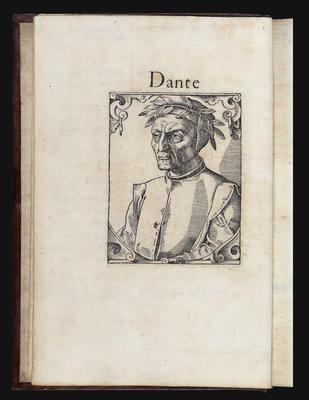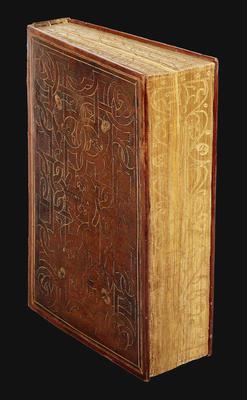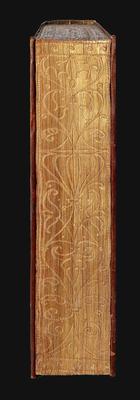Dante Alighieri
La Comedia di Dante Aligieri con la nova espositione di Alessandro Vellutello...
Venice, Francesco Marcolini, June 1544.4° (236 x 153 mm). Collation: AA-BB8, CC10, A-Z8, AB-AZ8, BC-BI8. [442] leaves. Italic and roman type. Three full-page woodcuts at the beginning of each cantica; eighty-four woodcut vignettes in text. With an extra leaf, bound before the title-page, not originally in the volume when issued, showing Dante's woodcut portrait from the Elogia virorum literis illustrium by Paolo Giovio (Basel 1577), here issued with some variants as a single sheet. Contemporary French calf, covers within gilt fillets, decorated with an elaborate strapwork on pointillé ground and floral tools; title lettered at the centre of the front cover, author's name at the centre of the rear cover. Later smooth spine gilt-tooled into a diaper pattern. Edges gilt and gauffered with floral design. Covers restored and inlaid. On the verso of the front flyleaf an early hand – in all likelihood Fugger himself – has copiedthe words of Dante's epitaph in Ravenna, restored by Bernardo Bembo in 1483. A very good copy, occasionally browned and stained.
Provenance: Marcus Fugger (1529-1597; his autograph signature on the front pastedown); Paul Harth (ex-libris on the front pastedown).
The first Commedia to contain the new and important commentary by the Lucchese Alessandro Vellutello (b. 1473), in a copy which belonged to the great bibliophile Marcus Fugger, a member of the celebrated Augsburg banking dynasty. This copy is the first state of the Marcolini edition, in which the terzina 64-66 is missing in the text of the second canto of the Purgatorio due to an oversight of the printer (fol. V7r). The book is justly famous for its illustrations, all newly designed for this edition. Each woodcut records one or more scenes from the cantos illustrated, and is closely related to Vellutello's glosses.The vignettes were possibly designed by Giovanni Britto, who worked as an engraver for Marcolini and probably cut by Marcolini himself. The volume is in a strapwork gilt-tooled and now extensively restored binding, produced for Fugger in Grolier's ateliers, probably by Gommar Estienne. A notable addition in the present copy is an extra leaf not originally in the volume as published, bound for Fugger as a frontispiece, with Dante's woodcut portrait taken from the Elogia virorum literis illustrium by Paolo Giovio (Basel, Perna, 1577). The Elogia woodcuts were designed by the Swiss painter and printmaker Tobias Stimmer (1539-1584), who in 1569-1570 was sent by Perna to Lake Como to make copies as drawings from the famous portrait collection assembled by Giovio. In 1577 Perna published the woodcut portrait of Dante, cut after Stimmer's designs, in the Elogia virorum literis illustrium, together with sixty-seven other portraits of illustrious men of letters, each surrounded by a strapwork frame. In the leaf bound into the present copy, however, the portrait of Dante is lacking the border found in the original edition, and the name of the poet is spelt in the variant form 'Dante' instead of the 'Danthes' in the Basel publication, although the identical font is used, perhaps stamped separately letter by letter, rather than printed as a single word. An unrecorded issue of the woodcut portrait, therefore, that might suggest the Stimmer series was issued individually as single-sheet prints.




